|
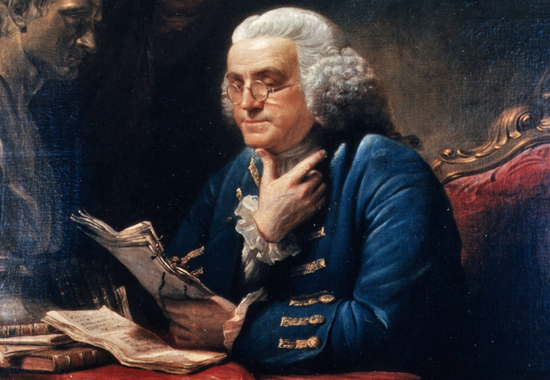
Benjamin Franklin 1706-1790
|
|
Image
Above
Detail from the
Portrait of Benjamin Franklin by David Martin
(1737-1797)
Library of Congress |
Famous for his kite experiment, which proved that lightning was
electrical, Benjamin Franklin worked as a writer, printer, publisher, and
businessman. He adopted many pen names, e.g. Richard Saunders.
Franklin was a remarkably active figure in politics. He was the
author of the Albany Plan of 1754, co-signer of the
 Declaration of Independence, the
Declaration of Independence, the
 Constitution of the United States
of America, the
Constitution of the United States
of America, the
 Treaty of Paris which ended the
Treaty of Paris which ended the
 Seven Years'
War, as well as the
Seven Years'
War, as well as the
 Treaty of Paris that
ended the
Treaty of Paris that
ended the
 American Revolution.
American Revolution.
On September 17, 1787, an aged Benjamin
Franklin had James Wilson deliver his
 Address to the Federal Convention shortly before the
Constitution was signed by the Convention at Philadelphia,
Pennsylvania.
Address to the Federal Convention shortly before the
Constitution was signed by the Convention at Philadelphia,
Pennsylvania.
Franklin invented the lightning conductor rod and invented or
improved many other devices. In addition, he was an excellent
promoter.
He had a hearty spirit for learning his entire life and kept a
weekly diary of his behavior to improve his personality. In England,
he gave swimming lessons in the river Thames. Franklin's services as
an international diplomat were much sought after because he was also
a skilled negotiator.
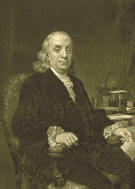
BENJAMIN FRANKLIN
1706 - 1790
Benjamin Franklin's
Family
Benjamin
Franklin's father was Josiah Franklin, a soap and candle maker who
was born in England and moved to Boston in 1683. Josiah Franklin married
twice.
Benjamin
Franklin's mother was Abiah Folger, Josiah Franklin's second
wife. She was born on Nantucket island, Massachusetts.
Abiah and
Josiah had ten children. Benjamin was the eighth child.
Benjamin Franklin's spouse was Deborah Read Rogers. Their children
were William,
Francis, and
Sarah.
Benjamin Franklin's
Inventions
Among other things, Franklin invented the Pennsylvania fireplace,
which after being improved by David Rittenhouse, was sold as the
Franklin stove.
Other inventions were swim fins, bifocal glasses, the odometer, and
the glass armonica, for which Mozart and Beethoven composed.
Franklin studied weather observation and helped to understand the
Gulf Stream.
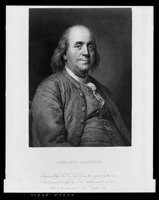
BENJAMIN FRANKLIN
Click image to enlarge
Benjamin Franklin's
Timeline
1706 January 17 - Birth in Boston, Massachusetts
1718 Apprentice in his brother's printing shop in Boston
(until1723)
1724 First trip to England
1728 Owner of a printing shop in Philadelphia
1729 Owner and publisher of the Pennsylvania Gazette
1730 Marries Deborah
1731 Founds the first subscription library in the colonies
1737 Postmaster of Philadelphia
1748 Retires from business
1753 Deputy Postmaster General, which puts him in charge of
mail in all the northern colonies
1774 Hutchinson Letters Affair
1775
 American Revolution (until 1783)
American Revolution (until 1783)
1776 Signs Declaration of Independence
1776 U.S.
Minister to France (until 1785). See also
 Vergennes
Vergennes
1783 The
 1783 Peace of Paris
concludes the American Revolution. The
1783 Peace of Paris
concludes the American Revolution. The
 Treaty of Paris
between Britain and the United States was
signed on September 3, 1783.
Treaty of Paris
between Britain and the United States was
signed on September 3, 1783.
1787 Signs the Constitution
1789 Washington becomes president
1790 April 17 - Death in Philadelphia
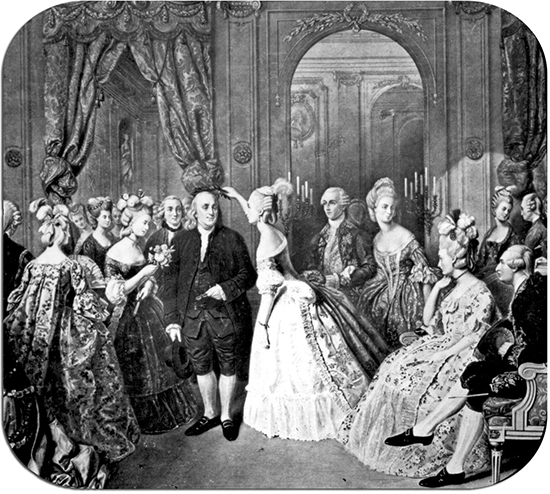
Benjamin Franklin at
the Court of France 1778
Painting by Hobens, Library of
Congress
Benjamin Franklin Book Review
I highly recommend Benjamin Franklin's autobiography. It is just 136
pages to read and it will give you the feel that you know the man. He
knew how to use a pen, which makes this book very enjoyable reading.
Plus, it is just two bucks or so, so there's really nothing you can do
wrong here. All thumbs up.
Here you
can
 read it online and free.
read it online and free.
Benjamin Franklin
Trivia
You can now win the Benjamin Franklin
award if you contributed to public diplomacy. Read all about it in
the
 Washington Post article.
Washington Post article.
 Benjamin
Franklin timeline here.
Benjamin
Franklin timeline here.
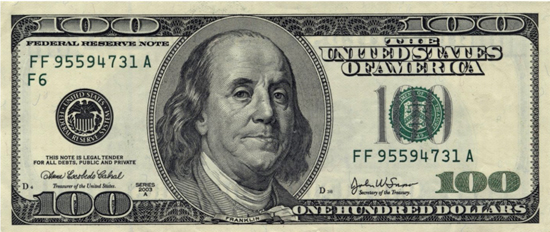
Benjamin Franklin on the 100 Dollar Bill
See also the
 American Timeline.
American Timeline.
More History
|